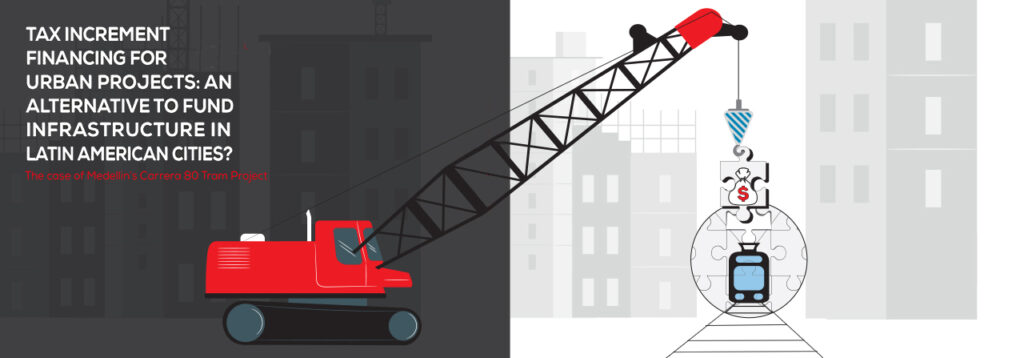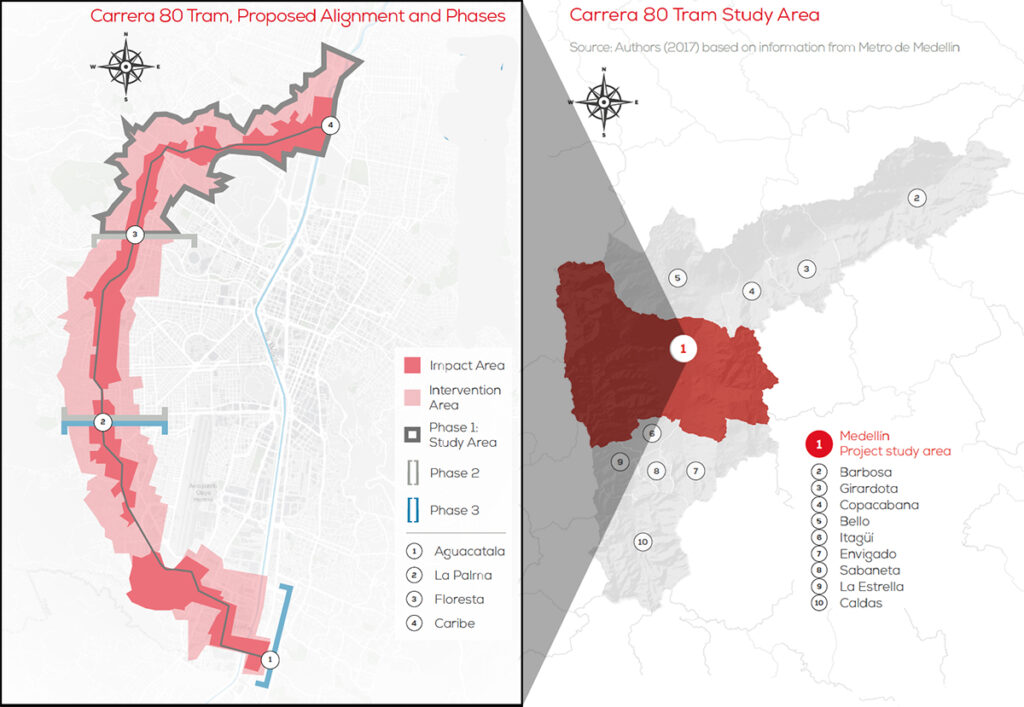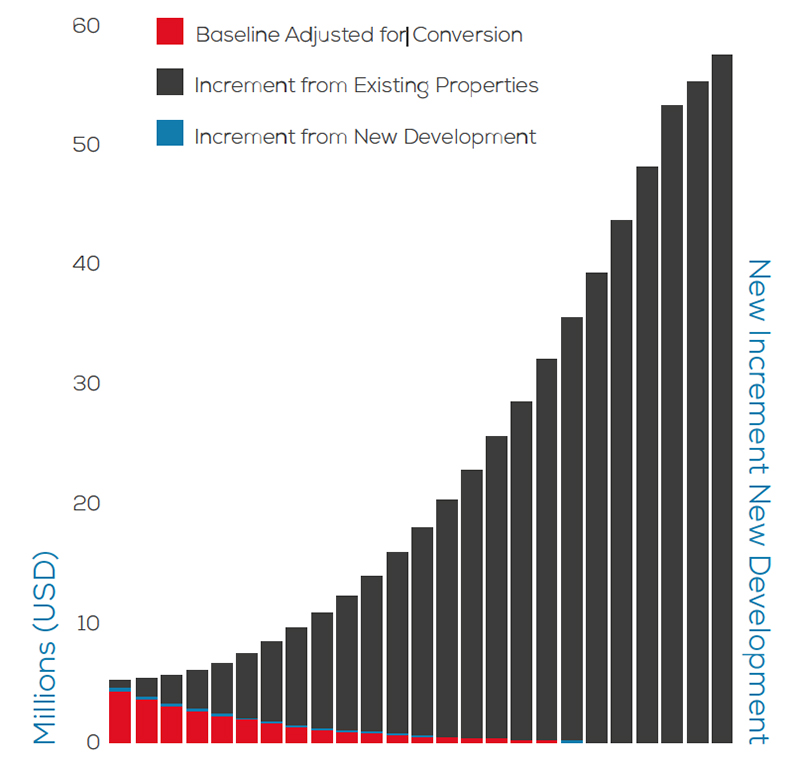Would it be possible for Tax Increment Financing (TIF) to work in Latin American and Caribbean (LAC) cities to expand local governments’ investment capacity in infrastructure?
The short answer is yes.
Although there are many factors to consider. The Urban area of the IDB’s research found that a handful of cities in the region could meet most of the critical factors needed to successfully implement TIF programs. This article summarizes the findings in the publication Tax Increment Financing for Urban Projects and presents a framework that discusses what cities need to do in order to implement a TIF and allow them to unlock land values to finance municipal infrastructure and spur economic development.

What exactly is a TIF?
Under a TIF program, anticipated increases in property taxes within a designated TIF district are earmarked against the repayment of a project loan, usually as a municipal bond. The loan is used to deliver a critical infrastructure project, such as a metro station, that, in turn, will likely appreciate real estate property values within its area of influence and lead to new development, which also creates additional property tax revenue. In other words, TIF allows cities to defray capital investment costs by partially capturing the economic benefits that public infrastructure investments generate.
What factors determine the successful development of a TIF?
In our research, based on an extensive literature review, we identified over 20 critical success factors that can be used to explain the likelihood of a TIF program being successfully rolled out by public authorities in LAC. We divided the factors into two groups. The first group covers a local government’s capacity to design and deliver a TIF program based on regulatory and institutional aspects. The second group focuses on the health of the economy and public finances. Together, these factors create a check list that municipal authorities can use to assess where they are and what they need to do to use TIF for infrastructure delivery.
| Municipalities’ capacity to design and deliver TIF programs | Economic and Financial Factors |
|---|---|
| Municipal control of land use planning, laws, and regulations | Sovereign credit rating |
| Multiyear investment program developed in accord with a long-term municipal development plan that is effectively communicated to stakeholders | Inflation rate |
| Protection of property rights, including the provision of adequate registration of property titles and legal ways for effectively resolving disputes over ownership | Consolidated fiscal balance of the national central government |
| Modern real estate cadaster with reliable, timely data on market values and other variables needed to estimate them | Degree of fiscal autonomy of the municipality |
| Legal right to define a special district for TIF | Financial management standards and reporting policies |
| Legal right to earmark municipal revenue from real estate property tax or other sources for specific use in the TIF district | Legal authority of the municipality to borrow |
| Legal right to adequately control and administer the real estate property tax and other municipal revenues to be used by the TIF district | Credit options: sources and currency |
| Develop plausible scenarios supported by reliable data concerning the increment of real estate property values in the TIF district | Surplus or operating deficit |
| Legal authority to use the value capture instruments needed to implement the financial strategy | Tax coverage and collection rate |
| Debt history | |
| Favorable economic outlook on the municipality’s real estate market cycle |
Medellin’s Carrera 80 Tram Project
After identifying and categorizing the critical success factors for TIF, we created benchmarks and assessed a group of LAC cities against them. We tested our framework in Mexico City, Montevideo, and Medellin. This allowed us to analyze where could TIF potentially work. Our findings, which are detailed in the full report, indicated that Medellin, Colombia was particularly in a strong position to deliver the region’s first TIF program. To validate our results, we conducted a feasibility assessment on the first phase of the planned Carrera 80 tram project.
Project Scope
The Carrera 80 tram project originally consisted of a new transit line which would be served by a tram system of approximately 14 km long with 20 stations along the way.

The tram line was planned as a state-of-the-art public transit system, which would transform the west corridor of Medellin with a compact and sustainable real estate development for a wide range of income groups. It would deliver new open spaces, public amenities, and pedestrian and bike lines. The nature of the intervention presented unprecedented opportunities for the use of value capture mechanisms to relieve the public sector financial burden and establish a self-sustaining operating scheme, making it an ideal project to test against the TIF criteria.
We first conducted a real estate market scan to determine how the tram project would likely transform the real estate market within its area of influence (a 500-meter radius). Our findings suggested that the project would accommodate at least 3.1 million m2 of new development between 2020-2044.
We then modelled how much additional property tax revenue would the city receive from new and appreciated real estate properties. We estimated that the Municipality of Medellin would effectively collect approximately US$571 million in incremental property tax revenue between 2020 and 2044. Depending on credit conditions, we estimated that the increment from property tax revenue could support between US$88 million and US$224 million in debt, which would cover between 21% and 55% of the CAPEX of the first phase of the tram project.

Areas for future research
Our research provides strong evidence that supports the claim that LAC cities can bring innovation into project finance by testing new instruments such as TIF. However, we acknowledge that getting the financials right is only part of the equation. There needs to a solid institutional and governance framework in place for cities to manage an efficient and transparent TIF program.
In early 2019, the Government of Colombia was the first in Latin America to allow local authorities to use TIF. However, many questions remain unanswered. For instance, what is the process for designing and approving TIF districts? How can municipal authorities earmark property taxes to repay TIF bonds? How will local authorities engage with property owners affected by TIF districts?
These questions, and others, will be addressed in a second study that is currently being implemented by Housing and Urban Development Division in another potential TIF district in Barranquilla, Colombia.
Special thank you to HR&A Advisors and David Vetter for their contributions to the publication.


Leave a Reply